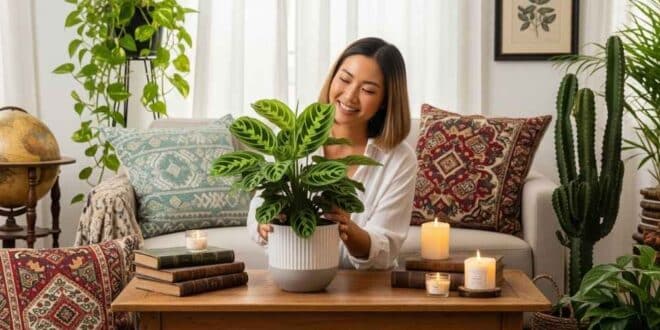Prayer Plant: A Living Prayer Bringing Movement and Beauty to Your Home
Imagine a houseplant that truly comes alive with the rhythm of your day, its leaves gracefully folding upwards at night as if in prayer, and then unfurling again with the morning light. That’s the enchanting Prayer Plant! The Maranta leuconeura, a widely recognized species, comes from the warm and humid rainforest environments of Central and South America, where it displays its captivating charm. It’s adored for its stunning, often intricately patterned leaves, unique daily movement, and a charming, gentle presence that adds a touch of magic to any indoor space. Ready to welcome this dynamic and beautiful plant into your home? Let’s explore everything you need to know to make your Prayer Plant thrive!
What Makes a Prayer Plant So Unique? Its Moving Leaves and Beautiful Patterns
The most fascinating thing about a Prayer Plant is its daily dance, a phenomenon called nyctinasty. As evening approaches, its leaves slowly fold upwards, resembling hands clasped in prayer. Then, with the first light of dawn, they gracefully flatten out again. It’s a truly mesmerizing show! Beyond this movement, the leaves themselves are a work of art. They’re typically oval-shaped, boasting a variety of vibrant green shades with striking, contrasting patterns in red, pink, or lighter green veins. The undersides of the leaves are often a beautiful reddish-purple, adding another layer of color.
Where Do Prayer Plants Come From? South America’s Tropical Understory
Your Prayer Plant’s ancestors hail from the warm, steamy rainforests of Brazil and other parts of Central and South America. In their natural habitat, they grow on the forest floor, thriving in the dappled sunlight and high humidity found beneath the dense canopy of taller trees. Understanding these origins is super helpful because it tells us exactly what kind of environment your Prayer Plant will love in your home!
What Are Its Other Names? “Prayer Plant” (of Course!) and More
While “Prayer Plant” is the most popular and fitting name, reflecting its unique daily leaf movement, its scientific name is Maranta leuconeura. You might occasionally hear it referred to by specific cultivar names that highlight its distinct patterns. The appeal, however, always comes back to that charming, almost spiritual, movement and its stunning foliage.
What Kinds of Prayer Plants Are There?
While Maranta leuconeura is the primary species, there are a few beloved varieties that offer different, equally beautiful leaf patterns:
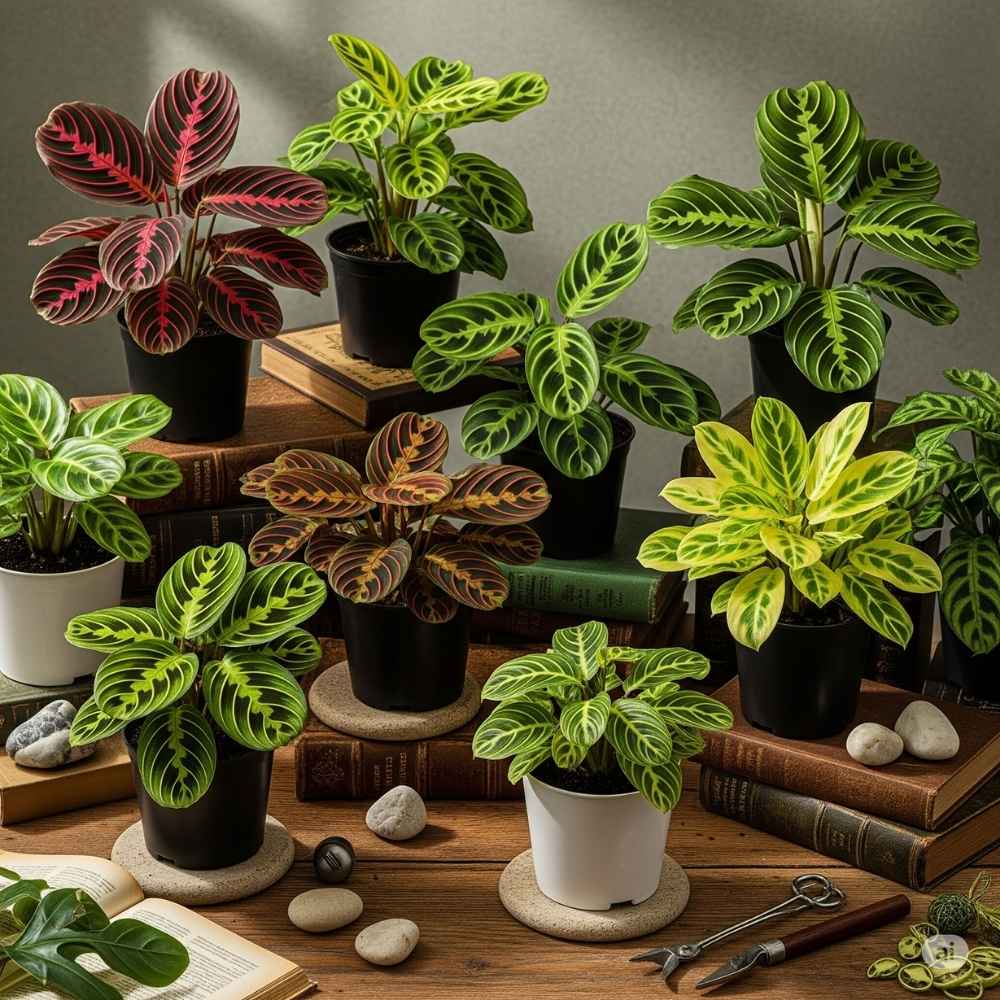
Popular Prayer Plant Types: From Red-Veined to Herringbone
- Maranta leuconeura ‘Erythroneura’ (often simply called Red Vein Prayer Plant): This is probably the most common and recognizable type. It features vibrant green leaves with striking, prominent red veins and a dark green border.
- ***Maranta leuconeura ‘Kim’***: Similar to the Red Vein, but often with lighter, more silvery-green leaves and slightly less intense red veining.
- Among its many forms, the Maranta leuconeura ‘Lemon Lime’ is a striking variety. Its most distinct feature is the bright, lime-green veining that strikingly contrasts with the darker green leaves.
- Maranta leuconeura ‘Fascinator’ (often called Herringbone Prayer Plant): This type has distinct red veins that branch out in a herringbone-like pattern from the central rib.
Leaf Looks: Colors, Patterns, and Textures
The leaves are where Prayer Plants truly shine! You’ll find them in various shades of green, from deep forest to bright lime. What really sets them apart are the intricate patterns: bold red veins, delicate lighter green markings, or even splashes of dark purple. The undersides are often a rich reddish-purple, adding to the color show, especially when the leaves fold up at night. The leaves usually have a slightly velvety or matte texture, making them soft to the touch.
Growth Habit: Bushy and Trailing
Prayer Plants typically grow in a low, bushy mound, making them perfect for tabletops and shelves. As they mature, their stems can start to trail gracefully, making them also wonderful candidates for hanging baskets where their beautiful foliage can spill over the sides.
How Do You Take Care of Your Prayer Plant?
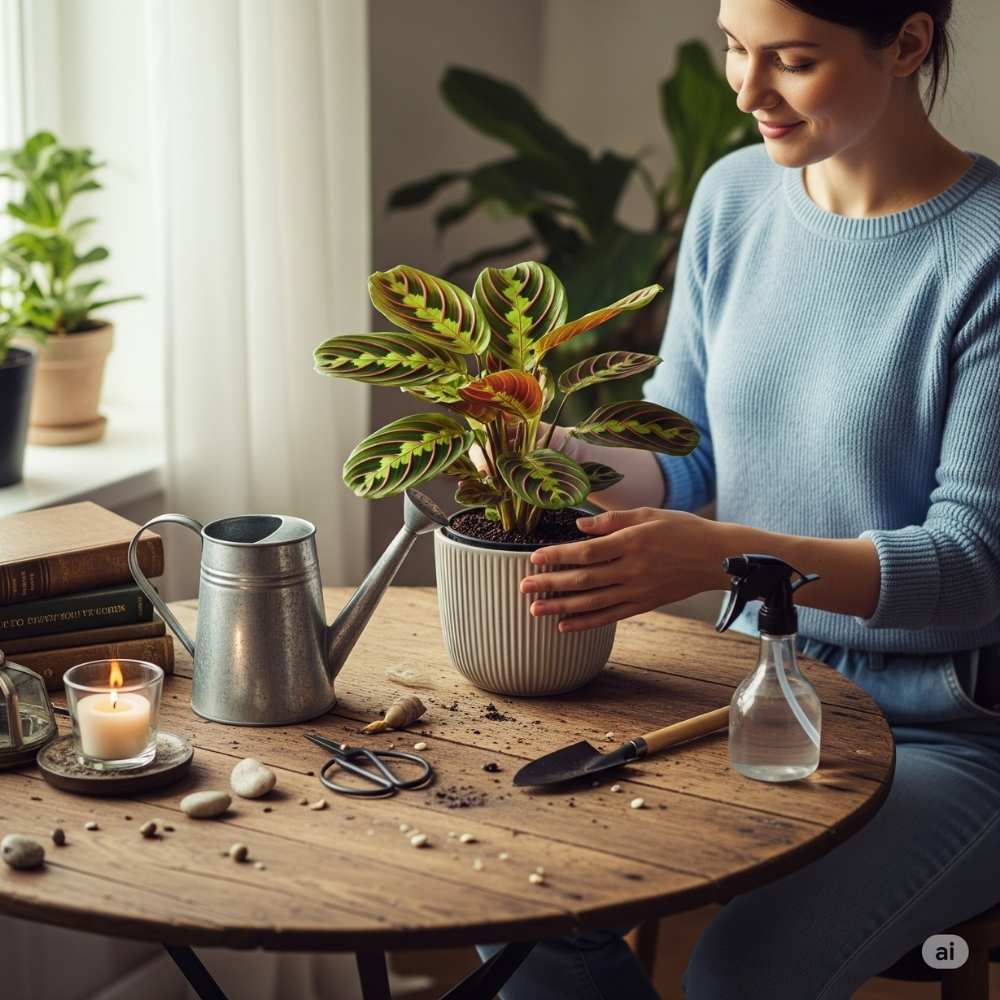
Prayer Plants have a bit of a reputation for being finicky, but don’t worry! With a little attention to their specific preferences, they’re actually quite rewarding to care for. The key is understanding their tropical rainforest roots!
The Right Light: Bright, Indirect Light is Essential
Your Prayer Plant loves bright, indirect light. Think of the light filtering through tall trees in a rainforest – bright, but never harsh or direct sun. A spot near an east or west-facing window is usually ideal. Too much direct sunlight will scorch their beautiful leaves, causing them to fade or develop crispy brown spots. If they don’t get enough light, their growth will slow down, and those vibrant leaf patterns might not show up as strongly.
Watering Smart: Keep Soil Consistently Moist, But Never Soggy!
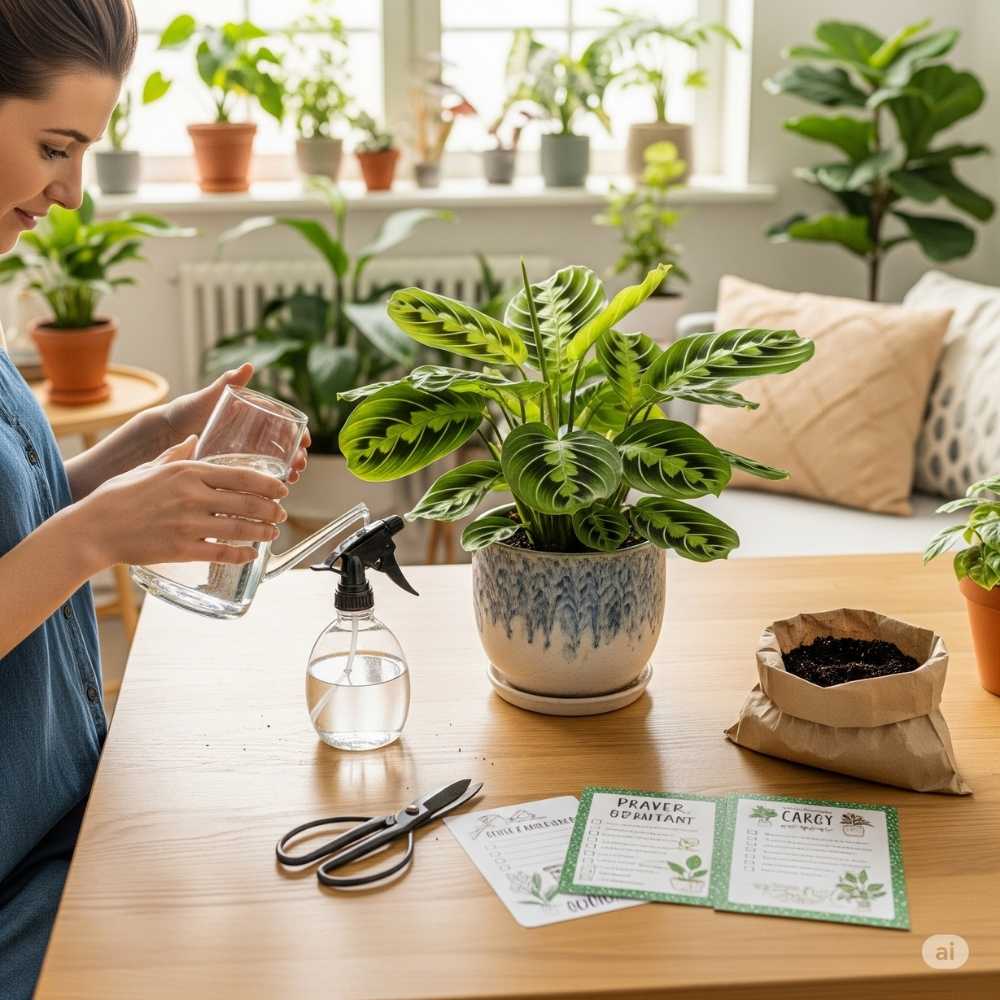
This is super important for Prayer Plants! They love consistently moist soil, but they absolutely hate soggy feet. Water your plant thoroughly when the top inch or two (2.5-5 cm) of soil feels just slightly dry to the touch. Don’t let the soil dry out completely! Make sure your pot has fantastic drainage holes, as standing water is a quick trip to root rot, which is a major problem for them. You can reduce watering slightly during the cooler, less active winter months.
Cozy Temperatures and High Humidity, Please!
Just like their steamy rainforest home, Prayer Plants crave warm temperatures, ideally between 65-85°F (18-29°C). They really dislike cold drafts and sudden temperature drops, so keep them in a snug spot! And humidity? Oh, they absolutely adore high humidity! If the air in your home is dry (especially with winter heating), you’ll almost certainly notice those annoying brown, crispy tips on their leaves. To make them feel right at home, consider using a humidifier, placing the pot on a pebble tray with water, or giving them a light misting regularly (using distilled or filtered water is best to avoid mineral spots!).
Choosing the Right Soil and Pot: Good Drainage is Key!
Prayer Plants prefer a potting mix that drains well and allows for good air circulation, yet can still retain a bit of moisture. A good quality indoor potting mix blended with perlite, peat moss, or coco coir will work beautifully. Remember to always select a pot with drainage holes; this helps prevent the soil from becoming saturated. Prayer Plants are quite content being slightly root-bound, so you’ll likely only need to repot them every year or two, or when roots are noticeably growing out of the drainage openings. Spring is typically the most suitable season for repotting.
Feeding Your Prayer Plant: Light Meals During Growing Season
During its active growth phase (spring and summer), your Prayer Plant prefers regular but gentle feeding. Therefore, consider using a half-strength, balanced liquid houseplant fertilizer every two to four weeks. You can then discontinue feeding entirely as fall transitions into winter.
Fixing Common Prayer Plant Problems
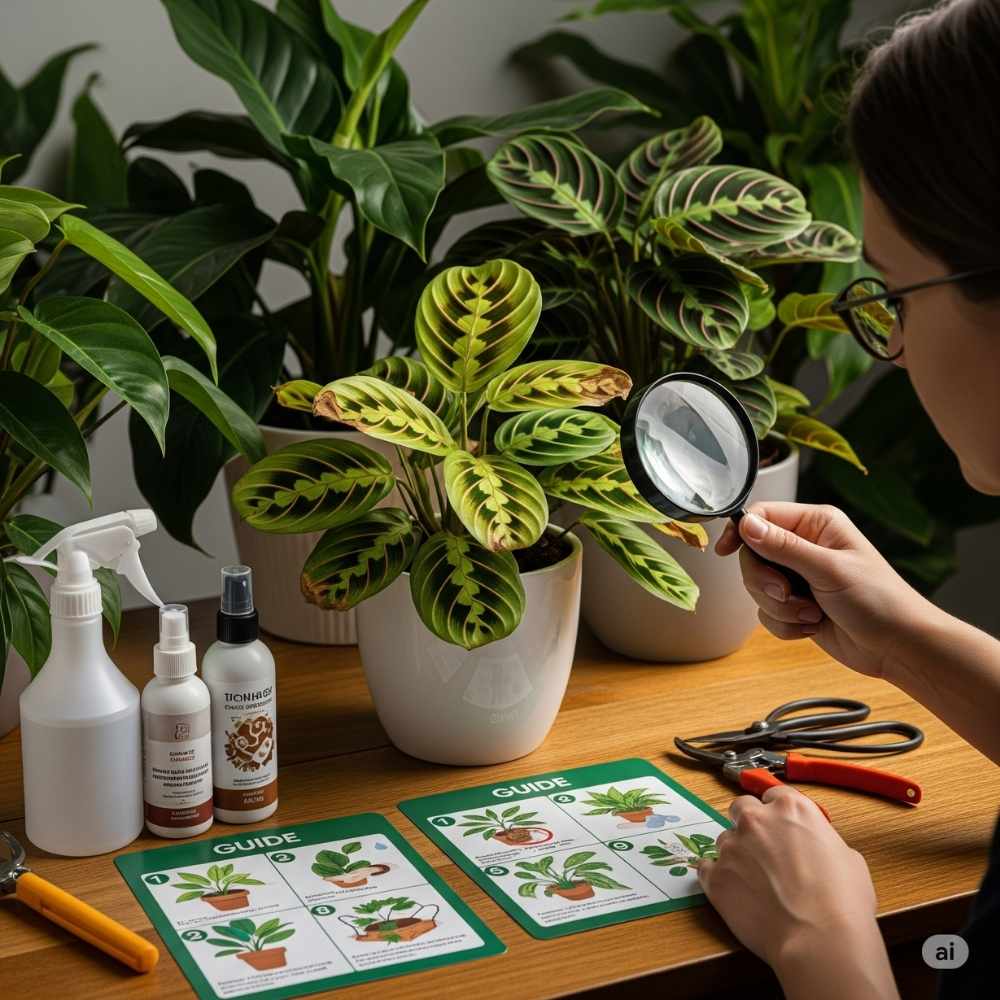
Even though they’re gorgeous, Prayer Plants can be a bit sensitive and will quickly show you if something’s not quite right. Here’s what to look out for:
Brown Edges? Likely Humidity or Water Issues
Brown, crispy leaf tips or edges are the most frequently reported problem for Prayer Plants. These symptoms almost always suggest either low humidity or a sensitivity to chemicals found in tap water, for instance, chlorine or fluoride. Over-fertilizing can also contribute.
- The Fix: To address these issues, raise the humidity for your plant (a humidifier or pebble tray is highly recommended!). Also, if your tap water is harsh, switch to distilled or filtered water, and verify that you aren’t applying excessive fertilizer.
Yellowing Leaves: Often Overwatering or Cold
When a Prayer Plant’s leaves start to turn yellow, it often signals overwatering. If the soil remains excessively damp, the roots may not get enough oxygen and could begin to rot. Furthermore, cold temperatures or drafts can also contribute to leaves turning yellow.
- What to do: Check your watering habits. Make sure the topsoil dries out slightly between waterings. And keep your plant in a warm, cozy spot, away from cold windows.
Leaves Not “Praying” (Folding Up): Stress or Light Issues
If your plant’s leaves aren’t folding up at night, it could be stressed. This might be due to too much light (they prefer shade), too little light, inconsistent watering, or temperature fluctuations.
- The Fix: Check your light conditions; ensure it’s getting bright, indirect light but no direct sun. Maintain consistent watering and temperature.
Fading Leaf Patterns: Not Enough Light
If those beautiful red veins or bright green patterns on your leaves seem to be fading, your Prayer Plant is likely not getting enough light.
- The Fix: Simply move your plant to a brighter location that still offers indirect light.
Pests: Watch Out for Spider Mites and Mealybugs
Prayer Plants can be a bit prone to spider mites (especially in dry conditions) and mealybugs.
- The Fix: Be sure to regularly check your plant, paying close attention to the undersides of its leaves. Should you find any small pests, address them promptly using insecticidal soap or neem oil.
Root Rot: The Big Danger of Overwatering
A major problem occurs when the soil stays wet for too long, leading to serious consequences.
The Fix: For best results, always provide excellent drainage and permit the soil to dry completely between each watering. If you suspect root rot (mushy stems, foul smell), you might need to repot it into fresh, dry soil after trimming any unhealthy roots.
Is the Prayer Plant Toxic? Safety for Pets

Good news for pet owners: The ASPCA, also known as the American Society for the Prevention of Cruelty to Animals, states that the Prayer Plant (Maranta leuconeura) poses no known toxicity risk to cats, dogs, or horses. Phew! This makes it a relatively safe choice for households with curious furry friends who might occasionally nibble on plants. While non-toxic, it’s always smart to gently discourage your pets from eating large amounts of any plant material, just in case it causes a mild upset tummy.
Prayer Plant for Your Home Decor: Bringing Movement and Color
The Prayer Plant is a fantastic choice for interior design, offering both visual beauty and a dynamic element:
Creating a Cozy, Tropical Nook
With its lush, colorful foliage and compact, bushy growth, the Prayer Plant is perfect for adding a touch of cozy, tropical charm to tabletops, shelves, and windowsills.
Showcasing Its Unique Movement
Place it somewhere you’ll notice its daily routine! On a bedside table, a living room shelf, or a desk, you’ll love watching its leaves “pray” at night and unfurl each morning.
Adding Vibrant Color and Texture
Those intricate leaf patterns and often reddish undersides provide a wonderful pop of color and rich texture, easily enhancing various decor styles from bohemian to eclectic.
Ideal for Terrariums and Humidity-Loving Groupings
Given its love for high humidity and relatively compact size, the Prayer Plant is also an excellent candidate for closed terrariums or for grouping with other humidity-loving plants.
The Allure of Prayer Plants: Dynamic, Detailed, and Delightful
The Prayer Plant is truly a living piece of art that actively engages with your home’s rhythm. It offers a captivating blend of stunning, detailed foliage, the fascinating spectacle of its daily leaf movement, and a relatively easy-care routine once you understand its preferences. By providing consistent moisture, bright indirect light, and plenty of humidity, you’ll enjoy the enduring beauty and tranquil presence of this magnificent plant for many years to come. It’s more than just a plant; it’s a tiny, captivating show that happens every single day!
Frequently Asked Questions (FAQ) About Prayer Plants
Still have some questions about your wonderful Prayer Plant? Here are some common ones that might help you out!
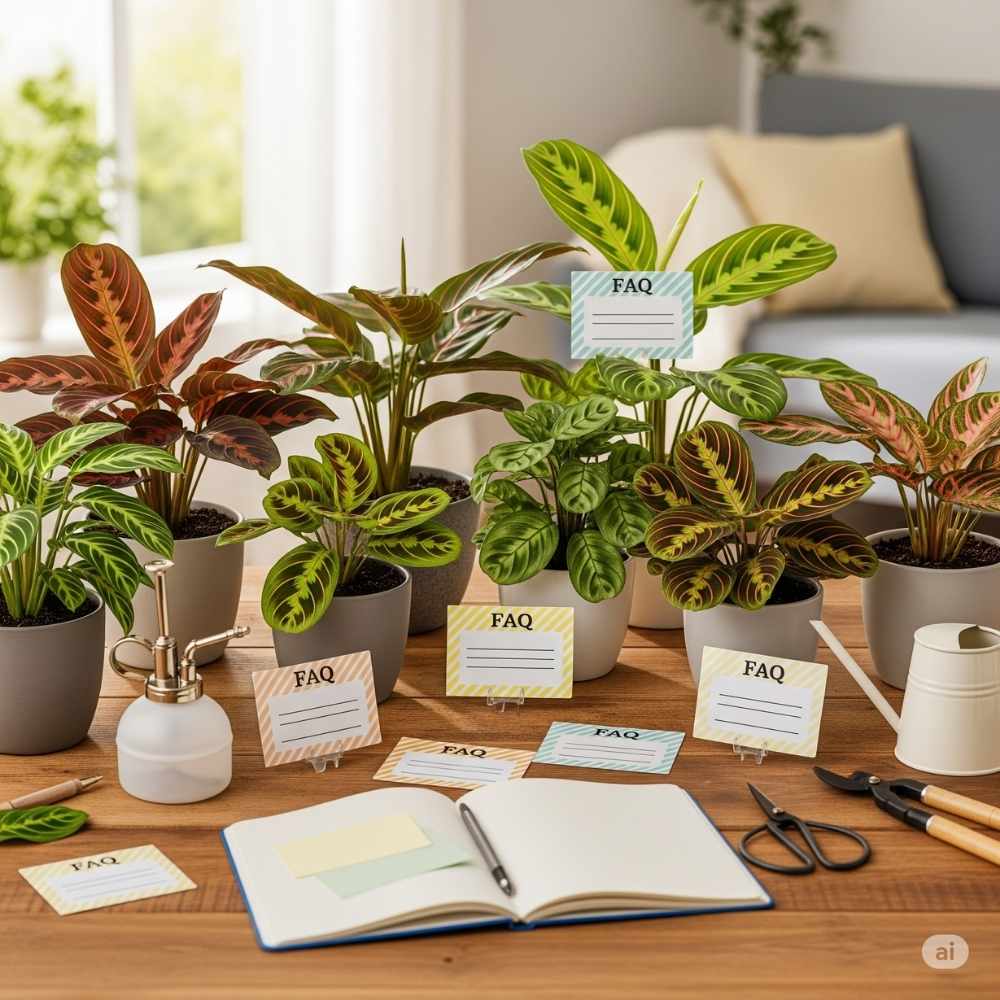
Q1: Why aren’t my Prayer Plant’s leaves folding up at night?
A1: If your Prayer Plant isn’t “praying,” it’s usually a sign of stress. The most common culprits are too much light (they prefer shadier spots!), too little light, inconsistent watering, or temperature fluctuations. For optimal growth, ensure it receives steady, bright, indirect light and maintains stable conditions.
Q2: How often should I water my Prayer Plant?
A2: Water your Prayer Plant when the top 1-2 inches (2.5-5 cm) of soil feel slightly dry to the touch. They love consistent moisture but absolutely hate soggy roots. Make certain your pot consistently provides superb drainage. You’ll likely water more often in warmer months and less in winter.
Q3: My Prayer Plant has crispy brown tips/edges. What’s wrong?
A3: This is the most common issue! Brown, crispy tips are almost always a sign of low humidity (they really need moisture in the air!) or too many minerals/chemicals in tap water (like chlorine or fluoride).
- The Fix: Increase humidity with a humidifier or pebble tray, and try using distilled, filtered, or rainwater for watering.
Q4: Do Prayer Plants need high humidity?
A4: Yes, absolutely! They come from tropical rainforests, so high humidity is crucial for them to thrive and keep their leaves from getting crispy. This is probably their most important care need after light.
Q5: Can a Prayer Plant live in low light?
A5: Bright, indirect light is what Prayer Plants favor most. While they can survive in lower light, their growth will slow down, and those beautiful, vibrant leaf patterns might become less distinct or fade. Too much direct sun, however, will scorch them.
Q6: What kind of soil is best for a Prayer Plant?
A6: For Prayer Plants, an ideal potting mix is one that allows good drainage and air circulation, while still being able to retain a degree of moisture. A good quality indoor potting mix amended with perlite, peat moss, or coco coir works beautifully.
Q7: How do I make my Prayer Plant look fuller?
A7: You can encourage a bushier plant by pinching back the longest stems right above a leaf node. This encourages the plant to branch out. You can also root these cuttings to create new, fuller plants!
Q8: Why are my Prayer Plant’s leaves turning yellow?
A8: Yellowing leaves are often a sign of overwatering (the soil staying too wet). It can also be caused by cold temperatures or a nutrient deficiency. Check your watering habits first.
Q9: Is the Prayer Plant safe if my cat or dog nibbles on it?
A9: Yes! Good news for pet owners. The Prayer Plant (Maranta leuconeura) is considered non-toxic to cats, dogs, and horses by the ASPCA, making it a safe choice for homes with pets.

